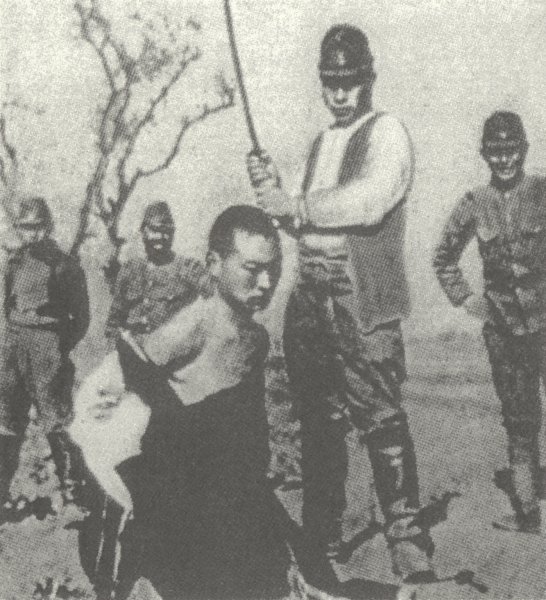
Photograph 1
The account of the Nanking Incident in one Japanese textbook states that "the Japanese people were not informed about the facts," implying that Japanese government or military officials issued a gag order prohibiting anyone from writing or speaking about the Nanking Incident. They did nothing of the kind.
The conviction that a gag order was imposed in connection with the Nanking Incident on the part of some proponents of the massacre argument probably stems from the fact that during the Second Sino-Japanese War (especially between late 1937 and the spring of 1938), the works of some writers were banned. Other writers were prohibited from publishing any of their work for a specific period of time. Still others were cited for violations of the Law Governing the Dissemination of False Rumors, but this had nothing to do with the Nanking Incident. Similar laws have been enacted by many nations in wartime, for obvious reasons.
Ishikawa Tatsuzo wrote a book entitled Living Soldiers, which was scheduled to appear in the monthly Chuo Koron in installments. Living Soldiers was banned as soon as the issue containing the first installment (March 1938) came out, on the grounds that the author had violated the aforementioned law. The text of the censors' decision on Ishikawa's case follows.
Living Soldiers is a novel that tells the story of a unit of the Imperial Army, beginning with its experiences on the North China battle front and ending when it lands at Baimaojiang in central China, in enemy territory, and participates in the invasion of Nanking. Almost every page is marked by hyperbole or portrayals that cast doubts upon the observance of stringent rules that govern the behavior of members of the Imperial Army, as described hereunder.
- Scenes in which Japanese soldiers brutally and indiscriminately slaughter enemy soldiers and noncombatants;
- Scenes that show Japanese soldiers looting in the South China battle zone, and create the impression that looting is an integral part of military policy;
- Scenes in which Japanese soldiers assault Chinese noncombatants while robbing them;
- Scenes in which Japanese soldiers violently assault Chinese women and girls in order to satisfy their sexual desires;
- Scenes that portray Japanese soldiers as having lost the will to fight and longing to return home;
- Scenes that depict Japanese soldiers as desperate men, both in thought and action.109
As readers will note, this ban concerned regulations prohibiting the slander of military personnel, and was not intended to conceal events that occurred in Nanking, regardless of their nature.
An examination of the regulations in force at the time reveals that a joint order from the Ministry of the Army and the Ministry of the Navy, issued on December 13, instructed newspapers to refrain from reporting on incidents involving damage inflicted upon foreign nations' ships by Japanese military personnel on the Yangtze River (the Panay and Ladybird incidents). The ban was lifted on December 15. Such orders were sometimes issued in advance, and at other times, when deemed necessary. However, none was issued in connection with the Nanking Incident, not by the Ministry of the Army, the Ministry of the Navy, or the Foreign Ministry.
Furthermore, penalties were imposed on three occasions in connection with newspaper articles about Nanking that violated regulations already in force governing the press. They concerned the December 17 edition of the Osaka Asahi Shinbun, the December 21 edition of the Tokyo Nichinichi Shinbun, and the December 25 edition of the Kokumin Shinbun. The reason: The newspapers in question had violated the Publishing Supervision Law, i.e., they had revealed military secrets by running a story about a canal's being constructed on the upper reaches of the Yangtze by Japanese naval personnel.110
In the process of collecting data for this book, we asked every former soldier we interviewed whether officers had imposed a gag order prohibiting them from writing about or even discussing the Nanking Incident. In each case, the answer was no. We posed the same question to former war correspondents, who replied unanimously that they were never subjected to any restrictions, save for restrictions they imposed upon themselves, something all responsible journalists do.
A. What 120 Journalists Saw
When the Japanese occupied Nanking, a city the size of New York's Manhattan Island, approximately 120 Japanese journalists and photographers accompanied them. Not one of them witnessed the massacre of women and children, or the mass slaughter of ordinary citizens or prisoners of war (with the exception of two journalists, Imai Seigo and Suzuki Jiro, whose accounts were fabricated). At that time, special correspondents for Japan's leading dailies (Asahi Shinbun, Tonichi Shinbun, Yomiuri Shinbun, and Nippon Keizai Shinbun),111 local newspapers, and wire services were stationed in Nanking. To a man, these correspondents were shocked when accusations of a "great massacre" in Nanking were made during the Tokyo Trials, as were soldiers who had served in Nanking.
On August 31, 1982, Hara Shiro, Shanghai correspondent for the Yomiuri Shinbun at the time of the occupation (and then an advisor to that newspaper), made the following comment to a Sekai Nippo reporter.
In a book entitled The Truth About the Conflict in Nanking: The Story of the 6th Division,113 published in 1966, Tokyo Nichinichi Shinbun correspondent Goto Kosaku wrote along similar lines.
Recently, an article by Hatanaka Hideo describing his interviews of well-known military figures who had served in Nanking and entitled "Interviews Conducted in Nanking on December 12, 1937" appeared in the magazine Sekai to Nippon.114 Of particular interest is the following exchange between Hatanaka and Ishikawa Tatsuzo, which took place shortly before the latter's death. As mentioned previously, Ishikawa's novel Living Soldiers was censored, and the author did actually receive a prison sentence, though he was granted probation.
Chapter 16
A Massacre with No Witnesses
I didn't hear about anything remotely resembling a massacre in Nanking until three months after the city fell. Military authorities hadn't issued a gag order, so I thought it was odd that I should be hearing news like that long after the supposed fact. I contacted all our bureaus, but wasn't able to obtain any definitive information. Most of the people I consulted believed that the "massacre" was yet another Chinese propagandist ploy.112
When the conflict in Nanking ended, I returned to Shanghai. Not long after that, I heard rumors that there had been a massacre in Nanking. Incredulous, I telephoned the Shanghai offices of Asahi Shinbun, Yomiuri Shinbun, Domei Tsushin, and other newspapers. Each time the answer was the same: "We haven't seen or heard anything about a massacre." I figured that this was another propaganda campaign launched by the enemy.
| Ishikawa | : | I went to Nanking two weeks after the ceremonial entry. |
| Hatanaka | : | What sort of atrocities did you witness? |
| Ishikawa | : | I saw no signs of a massacre - not one. |
| Hatanaka | : | What are your views on the "Nanking Massacre?" |
| Ishikawa | : | It would have been impossible to dispose of tens of thousands of bodies in two or three weeks. Even today, I'm convinced that no massacre ever took place.115 |
Ishikawa's words are of particular importance for the very reason that his book was censored, and he was treated like a criminal. In his book The Road to Nanking,116 Honda Katsuichi cites Living Soldiers, referring to it as a source of powerful evidence that a massacre did indeed take place in Nanking, an action that must have infuriated Ishikawa.
Hatanaka also interviewed Hashimoto Tomisaburo, a colorful figure who headed the Shanghai Bureau of the Asahi Shinbun in the late 1930's. During the Tanaka administration, Hashimoto served as secretary-general of the LDP,117 and as transport minister. Hashimoto and his team of 15 reporters were the first journalists to enter Nanking after the Japanese occupation. His response to a question posed by Hatanaka follows.
The Nanking Incident? Never heard a thing about it. If anything like that had happened, reporters would have talked about it, you can bet on that. After all, news is their business. I never even heard rumors of a massacre. We held meetings attended by every Asahi Shinbun reporter based in the area. If there had been a massacre, someone would have mentioned it, and even if they didn't call it a massacre, our reporters would certainly have voiced objections.
Hatanaka also interviewed Adachi Kazuo, the former Nanking correspondent for the Asahi Shinbun. When Hatanaka telephoned him to ask about the "massacre," Adachi's reply was curt: "I saw no evidence of a massacre in Nanking. I have no idea who you are, but if you want me to attest to a massacre in Nanking, I cannot help you."
After a brief exchange during which Hatanaka identified himself and explained why he had contacted Adachi, the latter agreed to an interview. Hatanaka asked about former Asahi Shinbun reporter Imai Seigo, who claimed to have witnessed a massacre. Adachi's comment was: "Imai wasn't in the habit of reporting on what he had actually seen. His talent lay in dramatizing stories he had heard from others."
In a roundabout way, Adachi was suggesting that an article that appeared in Bungei Shunju, in which Imai claimed to have witnessed the massacre of 20,000 persons, was suspect. His appraisal is identical to that provided to this writer by Moriyama Takashi, also of the Asahi Shimbun. Moriyama should know, since he shared a room with Imai in Nanking, and the two reported as a team. Imai never mentioned anything about a massacre to him.
B. Testimonies of Japanese Soldiers and Journalists
An eight-part series entitled "Japanese Witnesses to the Fall of Nanking," written by Ara Ken'ichi, appeared in the magazine Seiron, beginning in May 1986. Ara conducted exhaustive interviews with newspaper reporters, photographers, and soldiers who witnessed the fall of Nanking. He then compiled them into article form, without alteration. Due to space limitations, rather than providing a detailed analysis of this series, we will limit our discussion to the "massacre." The numbers that follow refer to the installments cited.
1. Onishi Hajime, former captain and staff officer of the Shanghai Expeditionary Forces
Onishi, the first person Ara interviewed, was the youngest intelligence officer in the 2nd Section. For approximately one year, he served as head of the Nanking Special Agency.
| Onishi | : | I served under Cho Isamu. If he issued an order [instructing his men to kill prisoners of war], I never saw it, nor did I hear anything about it ... in any case, it would have been extraordinary for someone in his position to give orders of that sort. |
| Ara | : | In his diary, Gen. Nakajima (Kesago), commander of the 16th Division, wrote: "Our policy is to take no prisoners." Some say that this passage is proof that prisoners of war were massacred. |
| Onishi | : | "Take no prisoners" meant that we were supposed to disarm them and let them go. The Chinese soldiers came from all over China, but it was their country, so they could walk home. |
| Ara | : | Did anyone in the Shanghai Expeditionary Forces mention that there had been a massacre? |
| Onishi | : | No, the subject was never broached. Once I entered Nanking, I made rounds of the city, ensuring that military discipline and regulations were observed. |
| Ara | : | And you saw nothing? |
| Onishi | : | I witnessed a rape once. |
2. Okada Takashi, former Army interpreter for Commander-in-Chief Matsui
There weren't any corpses within the city, so I don't think any atrocities were committed against civilians.They say that there were fires, but I don't remember any.
I did hear stories about prisoners of war. I heard that someone had tried to transport them from Xiaguan to the opposite bank of the Yangtze ... while they were crossing the river, chaos erupted and some of the prisoners were shot.
Okada Yuji, former major and Special Services officer, Shanghai Expeditionary Forces
During the conflict that ensued when we invaded Nanking, I noticed that some of the Chinese soldiers were women. I saw a dead female Chinese soldier. Some of the stragglers resisted, and then there were soldiers who weren't wearing uniforms. I saw some of them being executed. Perhaps people saw their corpses afterwards, and that's how the massacre rumor got started.3. Sato Shinju, former Tokyo Nichinichi Shinbun photographer
| Ara | : | They say there was a massacre. |
| Sato | : | I didn't see it. That's what they say, but by the 16th or 17th [of December 1937], street vendors were back in business. Not just in back alleys, but on main streets, too. Also, a lot of Chinese people were wearing armbands with the Japanese flag on them, and congregating around Japanese soldiers. I don't think they would have done that if Chinese people had been killed indiscriminately. |
| Ara | : | When did you first hear about the Nanking Incident? |
| Sato | : | Not until after World War II. It was during the American occupation, so it must have been 1946 or 1947. There was a radio program on NHK produced by the GHQ called "Box of Truth." On one of them I heard that there had been a massacre in Nanking. That was the first time I heard about it. |
Asai Tatsuzo, former photographer for the Motion Picture Department of Domei Tsushin
| Ara | : | Was there talk of a massacre or anything like that among the Domei Tsushin staff? |
| Asai | : | No, not a bit. There were a lot of stragglers, and soldiers in civilian clothing. We believed that getting rid of [executing] them was an unavoidable aspect of war. |
4. Taguchi Toshisuke, Hochi Shinbun war correspondent
| Ara | : | They say that a massacre was perpetrated in Nanking. |
| Taguchi | : | I never heard about it while I was there. No one ever mentioned it. |
Hosonami Takashi, former wireless engineer, Domei Tsushin
| Hosonami | : | There were corpses in the pillboxes, and also on the banks of the Yangtze. Some of them had been bound together with wire. |
| Ara | : | How many bodies were there? |
| Hosonami | : | About 100, 1 guess. They must have killed prisoners of war who were in Tangshan. |
5. Koike Shuyo, Miyako Shinbun reporter (entered Nanking on December13)
| Koike | : | All the houses in Nanking had been abandoned, so the city was deserted. You didn't hear a sound. There was a weird, ghostly air about the place - I didn't see one cat or dog. I was shocked because the streets were so still and silent. You would never have known that a battle had been fought there. |
| Ara | : | What was the situation in the Safety Zone? |
| Koike | : | The refugees were upset when Japanese soldiers searched for stragglers but, generally, the Safety Zone was peaceful. There wasn't any food. The refugees were starving, and would beg us for food. I found several sacks of rice at our lodgings, so I told one of the Safety Zone leaders to go there with me. I gave him enough rice and other food to fill two large carts. But there were 60 or 70 thousand people in the Refugee Zone, so I don't think my contribution made much of a difference. |
| Ara | : | They say that there was a massacre in Nanking. Did you see corpses that might have led you to believe that one had occurred? |
| Koike | : | I don't know if they were massacred, or died inbattle, but there were several bodies in the basement of a building that was under construction, near the central traffic circle... also, on my way toYijiang Gate, I believe, in a truck, I saw a body that had been squashed flat. It looked as though it had been repeatedly run over... at the docks at Xiaguan, there was a shipyard, circular in shape, that looked like a stadium. I saw piles of bodies that had been dumped there. |
| Ara | : | About how many bodies did you see at the docks? |
| Koike | : | More than five or 10 - maybe several dozen. I think they were corpses of soldiers who had died in battle. |
| Ara | : | Were there other bodies there? |
| Koike | : | No. |
Koike also mentioned that he had noticed a fire on Zhongzheng Road on December 13. This is crucial evidence, since on that same occasion, he saw foreign reporters traveling in two automobiles driving all around the city at full speed, the shutters of their cameras clicking away. This information contradicts the widespread perception that Japanese military authorities did not grant foreign journalists access to Nanking.
Higuchi Tetsuo, former Yomiuri Shinbun engineer
| Higuchi | : | Since I had an automobile, I drove around the city every day. |
| Ara | : | They say that the Japanese military perpetrated a massacre at about that time. |
| Higuchi | : | Well, I don't know anything about that. |
| Ara | : | You didn't see it taking place or hear about it? |
| Higuchi | : | I had no idea. I saw absolutely no evidence of a massacre. Yes, they say that one occurred, but I don't know where or how. The Zhongshan Mausoleum and similar sites were intact. They hadn't been desecrated. I think that our soldiers killed people only when their lives were in danger, and they're calling that a massacre. |
I was there for about a month, but I neither saw nor heard anything that would support the accusations I heard after the war. There couldn't have been a massacre. I simply cannot understand why they executed General Matsui.
Japanese soldiers did take prisoners, but there wasn't enough food to feed them, or facilities to house them. If they had let them go, the prisoners would have resumed military activity. They said they really didn't have any choice but to execute them. An NCO issued the orders - a squad leader, I think.
7. Tani Isamu, former colonel and chief of staff, 10th Army
| Tani | : | When I entered the city through Zhonghua Gate at about ll:30 a.m. on December 14, 1 saw very few bodies there. At about 3:00 p.m. I thought that, as commander of the Rear Section, I should inspect the occupied area. Accompanied by a sentry squad from Headquarters, we made the rounds of the city in automobiles. When we arrived at Xiaguan, there was a warship moored there. I met with the captain. There were quite a few corpses on that bank, perhaps 1,000, perhaps even two or three thousand. More than half of them were clad in uniforms. The others were dressed as civilians. |
| Ara | : | Were they killed during the conflict? |
| Tani | : | I think they were shot by the 16th Division while attempting to escape from the city. Perhaps that was what was later referred to as a massacre. |
| Ara | : | I've been told that there were corpses at Yijiang Gate as well. Did you see them? |
| Tani | : | Someone wrote that there were a great many bodies at Yijiang Gate. I went by there on the afternoon of the 14th, but there were no corpses there at that time. |
Tani opened his scrapbook, which contains a photograph of Yijiang Gate taken on December 14. The photograph shows the gate with its three entrances, but there is not a single corpse in sight.
| Tani | : | I also heard that there was a massacre at Yuhuatai, but there were no bodies there, either. |
Yoshinaga Sunao, former major and operations staff officer, 10th Army
| Yoshinaga | : | I entered Nanking on the morning of December 13, through Zhonghua Gate. |
| Ara | : | What was the situation in Nanking then? |
| Yoshinaga | : |
On my way to Chubei Bank, I encountered a Chinese family. They didn't arouse my suspicions, so I wrote a note on the back of my business card indicating that they should be permitted to cross the sentry line and handed it to them. Since families felt that it was safe enough to walk about the city that day (December 13), the situation in Nanking had obviously calmed down quite a bit.
Two or three days later I went to Xiaguan, on an operation. There were quite a few dead Chinese soldiers on the wharf at the Yangtze River - several thousand, perhaps. The 10th Army (the Kunisaki Detachment) had attacked not only from the south side of Nanking, but also from Pukou, so the corpses must have belonged to soldiers killed during those attacks. |
8. Kaneko Rinsuke, former captain and staff officer, 10th Army
| Kaneko | : | I entered Nanking on the 13th or 14th. I didn't see one corpse in the city, nor did I hear a single shot fired. |
| Ara | : | Then you heard nothing about a massacre at the time? |
| Kaneko | : | That's right. Not a thing. When I heard about it at the Tokyo Trials, I was astounded. I'm not trying to hide anything or hold anything back. The truth is that I saw nothing of the kind in Nanking, nothing that would leave an impression of that sort. |
Futamura Jiro, former photographer, Hochi Shinbun
| Ara | : | There's been talk of a massacre in Nanking. |
| Futamura | : | I didn't see anything like that when I was there. After World War II, I was often asked about it. I resurrected my memories of the time I spent there, but I had to ask the inquirers what they meant by "massacre." I have read what others have written about it. But there wasn't any site where people were murdered en masse like Auschwitz, you know. The first I heard about it was when the Tokyo Trials were held. |
C. Writers' and critics' accounts of their experiences in Nanking
Approximately 120 journalists and photographers entered Nanking subsequent to the Japanese occupation. However, they were not the only Japanese civilians to visit the city. Renowned commentators, writers, and poets, including Oya Soichi,118 Kimura Ki, Sugiyama Heisuke, Noyori Hideichi, Saijo Yaso,119 Kusano Shinpei,120 Hayashi Fumiko,121 and Ishikawa Tatsuzo were in Nanking when that city fell, or soon thereafter. Many other distinguished members of society spent time there during the spring and summer of 1938. Upon their return to Japan, all these visitors wrote reports describing their experiences, which appeared in magazines and newspapers. Some of them gave lectures.
For instance, Sugiyama Heisuke wrote a series entitled "Nanking" for the Asahi Shinbun. Kimura Ki wrote Early Spring in Jiangnan and Hayashi Fumiko, Journey to Nanking. Kobayashi Hideo122 penned From Hangzhou to Nanking. On the spur of the moment, poet Kusano Shinpei and Noyori Hideichi, president of the company that published Business World, travelled to Nanking together. Later, the former wrote A Land of Peace and Turmoil, which appeared in Business World, and the latter, Travels in China. Both men spent a good deal of time exploring Nanking and its environs, on foot and by car. Their accounts are vivid and detailed. However, none of the aforementioned accounts hints, even remotely, at a massacre.
Not long after World War II ended, the Tokyo Trials began. But even when criticism of the Japanese military and its tactics reached its peak, not one of these literary figures came forth with accusations of a "Nanking Massacre." The inimitable Oya Soichi, who was superbly capable of trenchant criticism, both oral and written, was no exception. As long as he lived, Oya dismissed accusations of a Nanking massacre.
D. What This Writer Saw in Nanking
This writer, too, visited Nanking in July 1938, subsequent to the Nanking Incident. I spent about a month in that city, on assignment for Pan-Asia magazine. In August, along with Hayashi Fumiko and a few others, I travelled with the 6th Division units headquartered on the right bank of the Yangtze, beginning with the invasion of Hankou in August. In October, our party was with the first unit to attack Wuhan.
Gen. Matsui Iwane, who was also chairman of the Pan-Asian Association, had instructed me to inspect the Nanking area, mainly to gauge the degree of public safety and the residents' reactions to the occupation. He had given me several letters of introduction. I was just a war correspondent, but the heads of the Nanking Special Agency and the Press Bureau went out of their way to assist me, ensuring that I saw every inch of the city. I visited Tangshuizhen, Xianhemenzhen, Jurong, and Pukou, as well as former battle sites in Nanking and areas in the city's immediate environs, including Xiaguan, Yuhuatai, and Zijinshan. My lodgings were in a communications barracks near the Drum Tower, which was located right at the entrance to the Safety Zone. Sentries were still posted there, checking civilian passports. Inside the Safety Zone, I saw the infamous thieves' markets, street hawkers, and row upon row of vendors' stalls. The Safety Zone was a beehive of activity, and Dafang Alley and similar places were bustling from early morning till night. By that time, the population had swelled to nearly 500,000. I even spotted female employees of Japanese-owned restaurants walking through the streets of Zouhui, Nanking's redlight district, clad in summer kimono.
According to testimony given at the Tokyo Trials and reports issued by the International Committee, acts of arson committed by Japanese soldiers had reduced more than one-third of the city to ashes. However, these claims were patently false. With the exception of Xiaguan, I saw much less evidence of destruction by fire than I had anticipated. In fact, I was surprised to find the city in such an orderly state.
Needless to say, I heard no rumors to the effect that a massacre had occurred in Nanking seven months prior to my arrival, though I was told, everywhere I visited, about the bloody battles that had ensued when the Japanese invaded the city. I will never forget the stories I was told about the brave Chinese soldiers who chained themselves to the pillboxes at Yuhuatai, and continued to fire their guns until they died, or the sight of the chains, which were shown to me.
The majority of war correspondents, photographers, writers, and poets who spent time in Nanking are united in their insistence that they neither saw nor heard any signs of a Nanking massacre until the Tokyo Trials commenced.
Further proof was supplied by Hosokawa Ryugen, former reporter and managing editor of the Asahi Shinbun, and then a political and social critic with an immense following. In 1986, on the Sunday preceding the anniversary of the end of World War II (August 14), Hosokawa appeared on "Candid Conversations About Current Events" aired by TBS (Tokyo Broadcasting System). Some of his comments follow.
When I was managing editor of the Asahi Shinbun, I assembled all the reporters who had been assigned to Nanking and asked them, individually, whether they had heard any rumors about a massacre in Nanking. And every single one of them replied, in no uncertain terms, that he had neither seen or heard anything to that effect... I can state with certainty that no massacre occurred in which tens or hundreds of thousands were killed.
Documentary photographs are powerful tools that are often used to bring an event to life or to prove that it actually took place. Therefore, the abuse or outright manufacture of such photographs is particularly reprehensible.
In pleading their case, those who believe (or who would have us believe) that a massacre was perpetrated in Nanking have made extensive use of photographs. When these so-called documentary photographs were first disseminated, they were immensely effective in swaying public opinion, convincing many people that the charges were accurate. However, when subjected to scrutiny, every one of these photographs was proven not only to have no connection with any event that took place in Nanking, but also to have been (1) faked or otherwise adulterated for propaganda purposes, (2) supplied with spurious captions, or (3) of unknown (and therefore, suspicious) provenance.
Iris Chang's The Rape of Nanking includes 12 pages of photographs. However, we can state with certainty that not a single one of them bears witness to a "Nanking Massacre." (See "A Study of "The Rape of Nanking" by Higashinakano Shudo and Fujioka Nobukatsu for a detailed treatment of this subject.)123 In this chapter, we will show how they have been misrepresented, focusing on three photographs from Chang's book, which have also appeared in other books, as well as newspapers and magazines.
There is no dearth of photographs that portray the true situation in Nanking in late 1937 and thereafter. As I stated in Chapters 16, 120 Japanese newspaper reporters and photographers entered Nanking along with invading troops. The journalists were extremely diligent about gathering information and writing reports, which they wired to Japan nearly every day. As long as they didn't reveal any military secrets, they were free to cover whatever they liked. They explored every nook and cranny of Nanking, a rather small city, and took thousands of photographs. Those photographs were reproduced in hundreds of magazines and newspapers. Not one of them (even those that did not appear in the media) depicts a massacre. Postwar newspaper reporters, eager to prove that a massacre took place, have scoured photographic archives, looking for evidence. Their rummaging has been fruitless, which is not surprising, since none ever existed.
We have reproduced some of the photographs from four collections featured in the Asahi Shinbun, one of Japan's leading newspapers, during the month following the fall of Nanking on December 13, 1937 (on December 20, 22, 25, 30, and January 3). The newspaper also carried articles about Nanking under the Japanese occupation. It would be mistaken to construe these as propaganda photographs. They are genuine photographs taken by representatives of one of the dozen or so Japanese newspapers covering Nanking. Furthermore, they were published as soon as they were received, and were not altered in any way. These photographs present a true picture of life in Nanking at the time, and demonstrate that there was absolutely no basis for accusations of a massacre. (Unfortunately, they have been preserved only in reduced size, so they are not as clear as we would like. But they are authentic records of the situation in Nanking after the hostilities had ended.)
As we mentioned earlier, there are thousands of contemporaneous photographs that speak the truth about Nanking, which include those taken by individuals as well as journalists. Currently, we are in the process of assembling and cataloguing these photographs, which we hope to disseminate in the near future. A. Faked or Misrepresented Photographs in The Rape of Nanking
Example 1

Photograph 1
This photograph has been reproduced in many publications (e.g., in the May 21, 1997 issue of Newsweek, Japan issue). However, it is a total fake - a composite created for propaganda purposes. The fakery is easy to detect if you look at the shadow cast by the man at the center brandishing a Japanese sword, and that cast by the soldier to his right. They are facing in different directions. Furthermore, the soldier with the sword is wearing a type of jacket never worn by Japanese soldiers. Any Japanese would be shocked to learn that this photograph had fooled the world's media.
Example 2
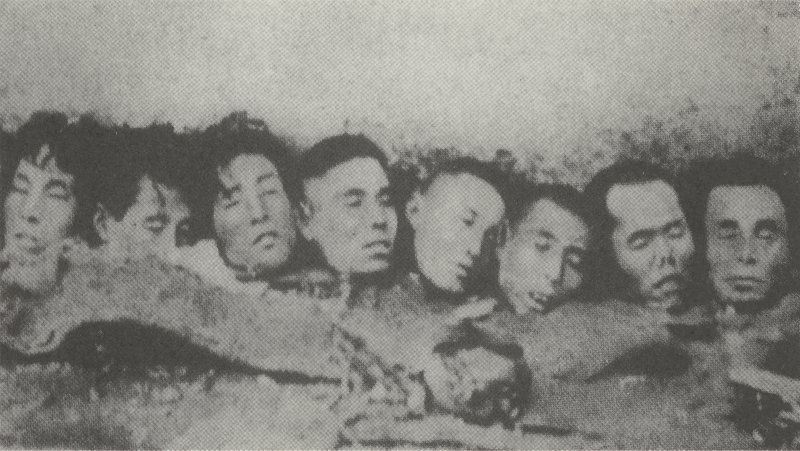
Photograph 2
The photographer's name and the site where the photograph 2 was taken are unknown, but we are certain that it has no connection with the Nanking Incident. This photograph has appeared in several books, eventually metamorphosing into evidence of the "Nanking Massacre." One of those books is A Collection of Photographs of the Japanese Invasion of China issued by the Xinhua Publishing Co. in 1984.124
The photograph made its next appearance in 1997, in the second edition of a book edited by Shi Yong and bearing the same title as Chang's book, The Rape of Nanking, which also contains a photograph identical to this one (Photograph 2A). Its caption reads: "According to an article in the August 4, 1984 edition of the Asahi Shinbun, this is one of three photographs brought back to Japan by a former soldier who saw action in Nanking, and now resides in Miyazaki. "125
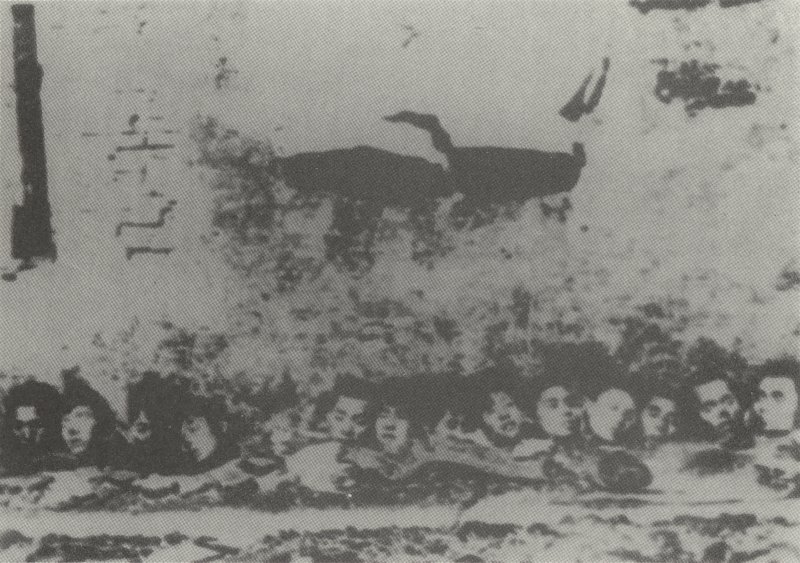
Photograph 2A
However, the Asahi Shinbun article turned out to be totally erroneous. Another former soldier named Sato Susumu, a resident of Kanagawa Prefecture came forward and announced that he was in possession of a photograph identical to the one reproduced by the Asahi Shinbun. Mr. Sato joined the 19th Engineer Battalion at Huining, near the border between North Korea and China, in October 1931 , and was assigned to guard duty at the border. Toward the end of that year, he bought 10 photographs, all similar in nature, which were being sold as souvenirs at a combination stationery store and photographer's studio in Huining. One of them was the photograph in question. The caption on the photograph purchased by Mr. Sato reads "Heads of Bandits Shot to Death in Tieling" (Manchuria). The bandits were shot and subsequently decapitated by the soldiers of Zhang Xueliang (1898- ), Manchurian warlord and, for a time, Nationalist government chief in Manchuria.
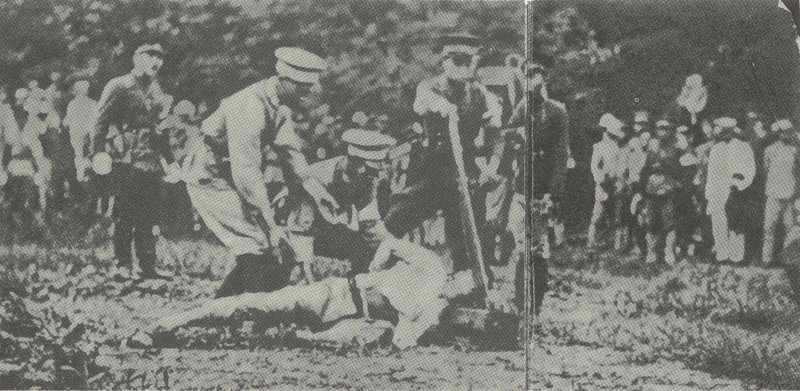
Photograph 2B
Photograph 2B (which appears both in A Collection of Photographs of the Japanese Invasion of China and Shi Yong's The Rape of Nanking, and which is identical to another of the 10 owned by Mr. Sato) shows soldiers using a large hay cutter to sever a man's head. The soldiers are wearing Nationalist uniforms, so they are Chinese, not Japanese. The Asahi Shinbun, realizing its error, printed an apology in which it retracted the August 4 article in its entirety.
However, A Collection of Photographs of the Japanese Invasion of China maintains that the heads in this same photograph are those of Chinese murdered while defending their nation against the Japanese. Its authors have miraculously transformed bandits executed by Nationalist soldiers into Chinese massacred by Japanese troops. In The Rape of Nanking, Shi Yong, inspired by the erroneous article in the Asahi Shinbun, claims that the severed heads are presented as victims of the conflict in Nanking. Going a step further, Iris Chang asserts that this photograph constitutes proof of the "Nanking Massacre." This is another example of the depraved methods used to concoct "evidence."
Example 3
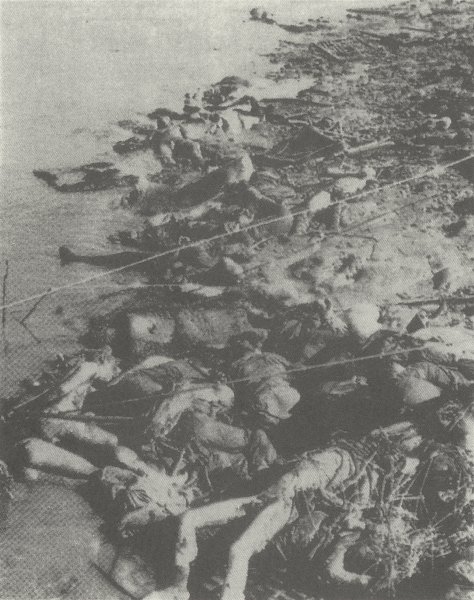
Photograph 3
The provenance of this photograph has been ascertained. It was taken by former soldier Murase Moriyasu. The version that appears in Chang's book has obviously been trimmed, for reasons that are not clear to us (Photograph 3A is the original). Murase took this panoramic photograph at the juncture of the Yangtze and Jia rivers. Takahashi Yoshihiko (former major and head of an observation party attached to the Headquarters of the 2nd Independent Mountain Artillery Regiment), who took part in a conflict on the upper reaches of the Yangtze at Xinhezhen, was kind enough to provide an explanation. At about 6:00 a.m. on December 14, 1937, Takahashi's unit encountered a large group of enemy soldiers who had fled Nanking through Yijiang Gate, at Xinhezhen. An intense battle ensued. Though greatly outnumbered, the Japanese persevered and finally, at about 11:00 a.m., prevailed. Their opponents began jumping into the river. The Japanese fired at them from the bank, killing most of them. Their corpses were carried by the current to the confluence of the Yangtze and Jia rivers, where this photograph was taken. Since most of the bodies are facing in the same direction, it is obvious that, carried by the current, they drifted downstream, clustering as they neared the riverbank.
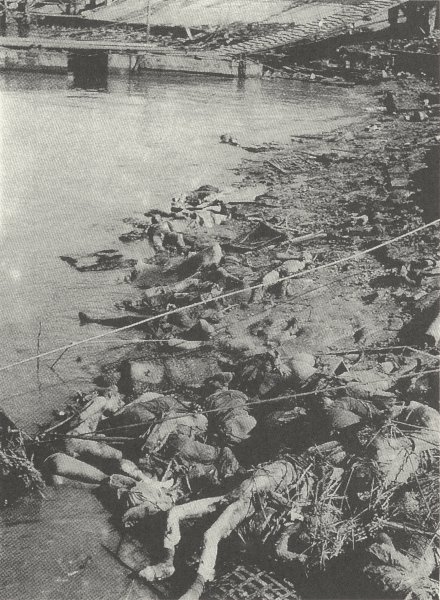
Photograph 3A
This is, without a doubt, a ghastly scene. However, these men were combatants who were killed during a war. They cannot rightly be called massacre victims, as we argued in Chapter 1. What are we to make of a nation that attempts to gain the sympathy of the international community by complaining that its war dead were victims of a massacre?
B. Authentic Photographs Portraying Life in Nanking After the Conflict
Asahi Shinbun Feature No.1:
December 20, 1937
Title: "Peace Returns to Nanking: Joyful Residents of Nanking Welcome the Imperial Army"
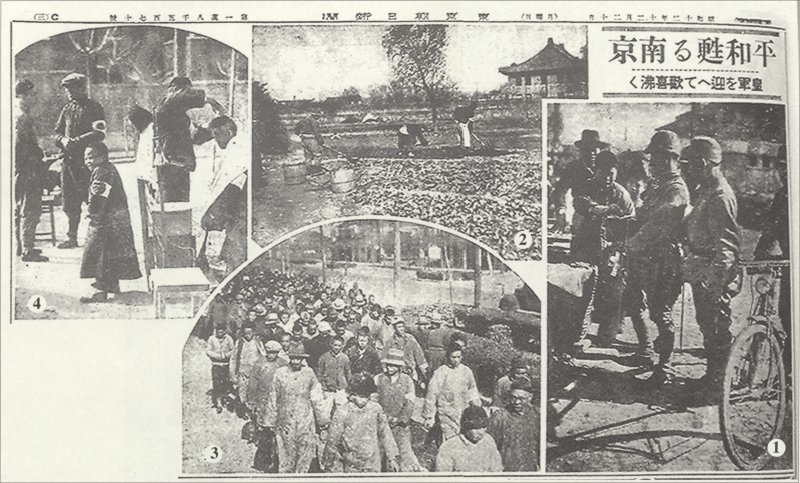
Photographed by Asahi Shinbun correspondent Kawamura on December 17.
1: "Soldiers Enjoy Shopping in Nanking" (By the fifth day of the occupation, outdoor stalls had cropped up all over the city. Note that the soldiers are unarmed.)
2: "Now that the Imperial Army has entered Nanking, farmers can tend their fields outside the city in safety"
3: "A group of returning refugees escorted by the Imperial Army" (With peace restored, residents who had evacuated to areas outside the city, felt that it was safe to return to their homes, and streamed back into the city. See Chapter 3, p.19.)
4: "An open-air barbershop in a peaceful city" (Open-air barbershops have long been a common sight in China. In this photograph, smiling adults and children are wearing homemade armbands depicting the Japanese flag. By the fifth day of the occupation, street vendors selling all sorts of wares were open for business, and soldiers strolled around the Safety Zone without their weapons.)
Asahi Shinbun Feature No. 2:
December 22, 1937
Title: "Yesterday's Enemy Is Today's Friend: Japanese Acts of Kindness"
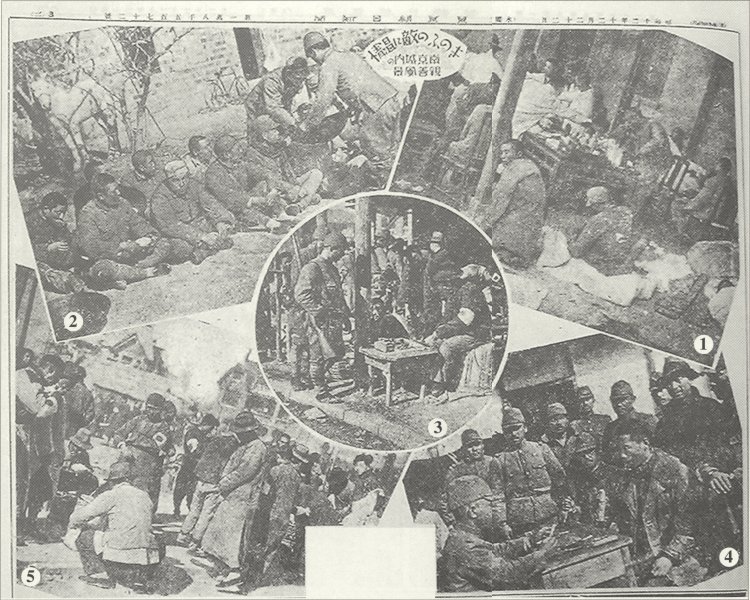
Photographed by Asahi Shinbun correspondent Kawamura.
1: "Wounded Chinese soldiers receiving medical treatment" (Wounded members of the Nanking Defense Corps, abandoned by their commander, Tang Shengzhi, are treated by a Japanese army physician and a member of the medical corps.)
2: "Hungry prisoners of war are fed by Imperial Army soldiers" (Compliant prisoners were treated kindly.)
3: "With the guns of war now silent, good will reigns in Nanking"
4: "Training Unit Staff Officer Maj. Shen Boshi chats with the commander of the Tayama Unit" (The Training Unit was the Chinese Army's elite division. Later, Maj. Shen later served in Wang Jingwei's administration.)
5: "Friendships Blossom in Nanking"
Asahi Shinbun Feature No.3:
December 25, 1937
Title: "Nanking Smiles: City Sketches"
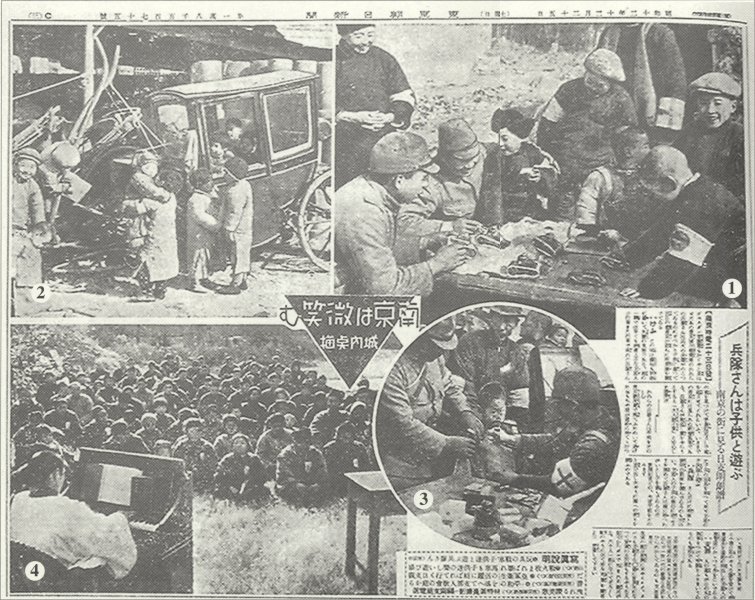
Photographed by Asahi Shinbun correspondent Hayashi.
1: "Children playing with toy tanks - Japanese soldiers join in the fun (on Zhongshan Road, Nanking)"
2: "Now that the war has ended, neighborhood children use a broken carriage as a playhouse (in a residential area of Nanking)"
3: "The kindness of members of the Imperial Army's Medical Corps deepens Sino-Japanese friendship (in the Refugee Zone)"
4: "Hymns in praise of peace resound from a church garden (on Ninghai Road, Nanking)" (John Magee was the pastor of this church - the Episcopal Church of Nanking. The photographs he took were later used as evidence of a massacre, but the subjects of most of them are persons wounded in the war. Rev. Magee was a witness for the prosecution at the IMTFE, where he testified for two full days, enumerating several hundred Japanese atrocities. However, when he was cross-examined by defense attorneys, he conceded that he had personally witnessed only one murder. Pressed to elaborate, Magee said that he had seen Japanese soldiers kill a straggler who was trying to escape. But in his diary, he reveals that he had perjured himself - he writes that he had not witnessed the murder. This photograph exposes the huge difference between his claims of Japanese atrocities and the truth.)
Asahi Shinbun Feature No.4:
December 30, 1937
Title: "Sino-Japanese Friendship Deepens as Nanking Prepares to Greet the New Year"
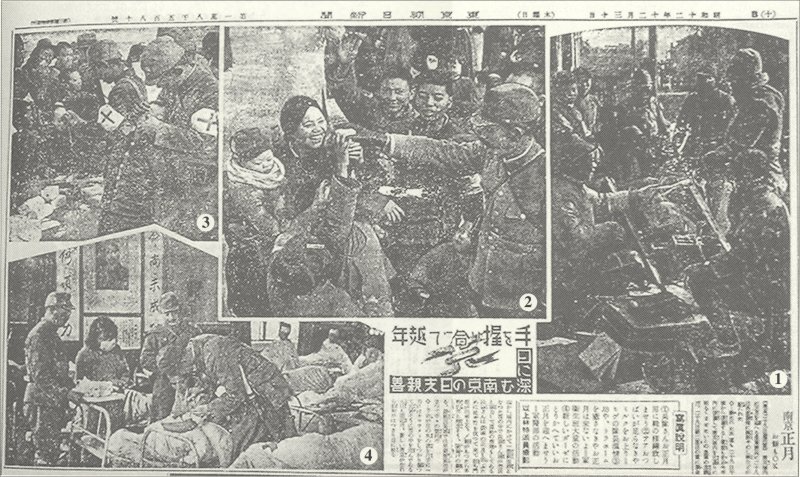
Photographed by Asahi Shinbun correspondent Hayashi.
1: "Chinese shoemaker offers to repair soldiers' boots for the New Year."
2: "A grateful mother receives milk for her child from a kind Japanese officer"
3: "The Medical Corps in action: Comforting a little boy as he is treated for trachoma"
4: "A Medical Department in action: Changing a dressing" (This feature is accompanied by an article entitled "Nanking Anticipates the Arrival of the New Year, Complete With Rice Cakes.")
Memorial Services Held for Chinese Soldiers Killed in Action
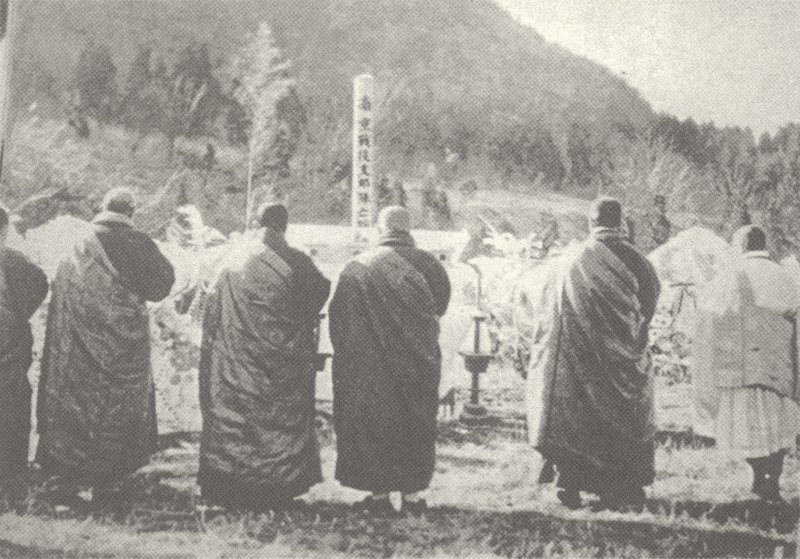
Source: Illustrated Weekly, No.27 (February 8, 1938) issued by the Cabinet Information Office
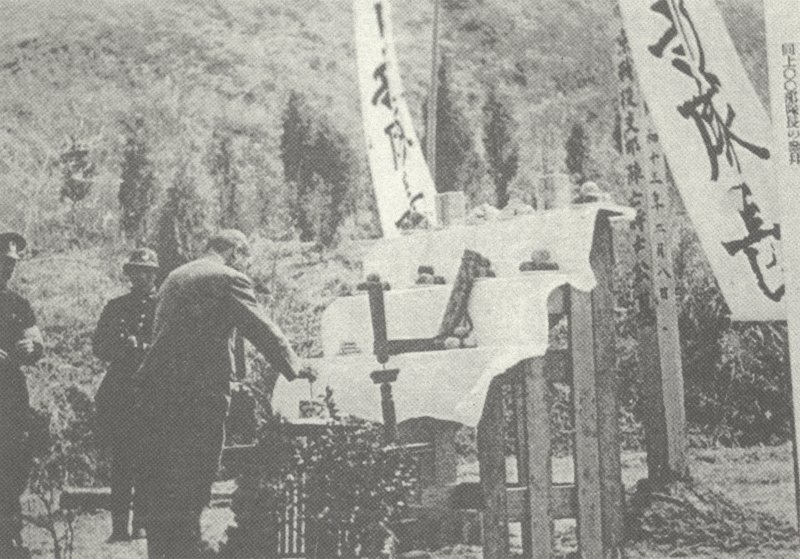
Source: The Second Sino-Japanese War: An Illustrated Report, March 1938 (Osaka Mainichi Shinbunsha)
The photographs shown above were taken at a memorial service for Chinese soldiers killed in action. The service took place on February 8, 1938 under the auspices of Japanese military authorities and the Nanking Self-Government Committee at a cemetery near Yijiang Gate. Both Japanese and Chinese priests officiated. Col. Uemura Toshimichi, chief of staff of the Shanghai Expeditionary Force, wrote the following account of the service in his warjournal on that same day.
We held a memorial service for Chinese soldiers at Yijiang Gate. They were our enemies, but offerings of flowers to one's fallen enemy is a demonstration of compassion, which is an integral part of bushido. Members of the Self-Government Committee, as well as Japanese and Chinese priests, were in attendance.126
The photograph shown below was taken on February 28, 1938, the date on which another memorial service, arranged by Lt.-Gen. Fujita, commander of the 3rd Division, was held at the same site. Otani Koyo, head priest of Higashi Hongan Temple in Kyoto, officiated.
These photographs are contemporaneous records, and they prove that Japanese military personnel adhered to the bushido code by praying for the repose of the souls of the enemy dead. They should also negate the evil demagoguery that led the world to believe that Japanese soldiers murdered Chinese indiscriminately or orchestrated a holocaust.